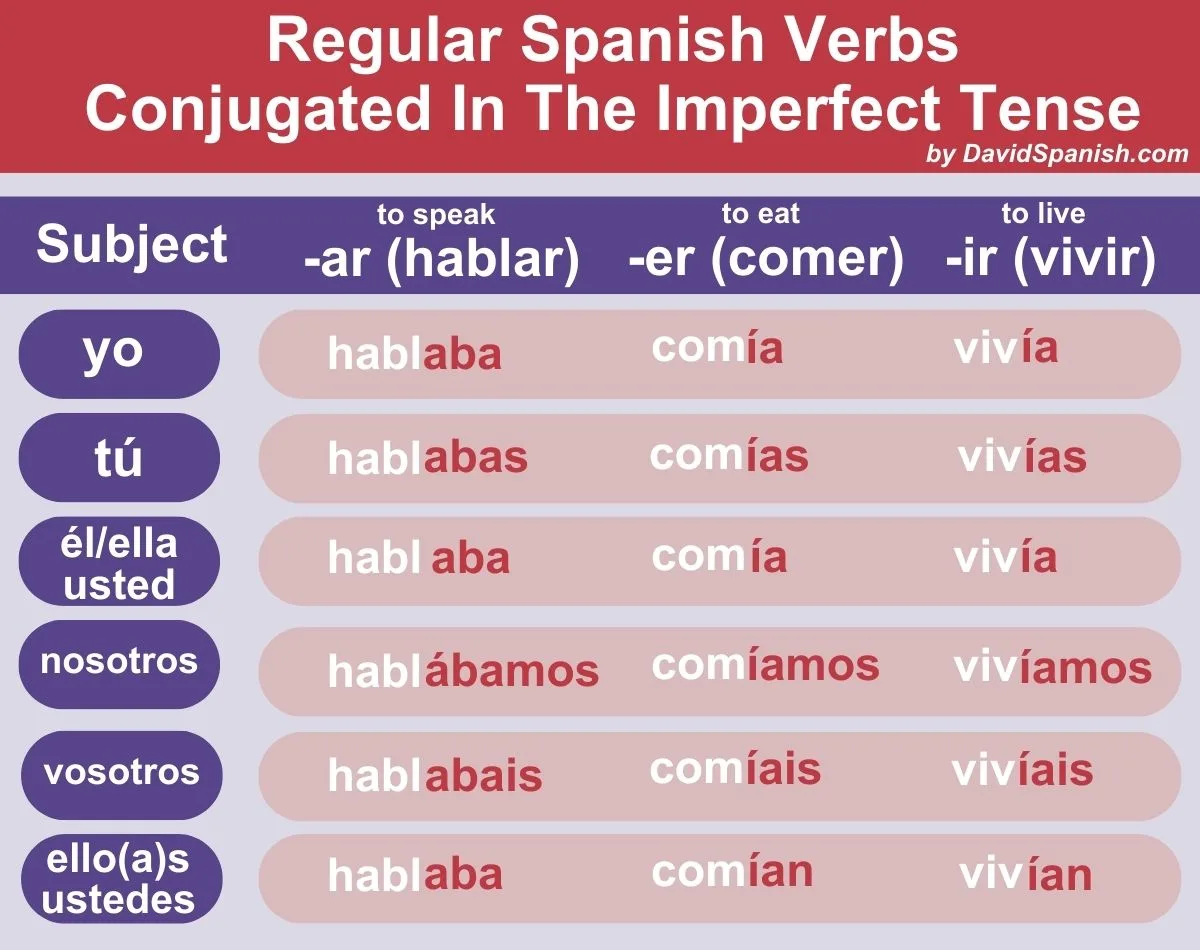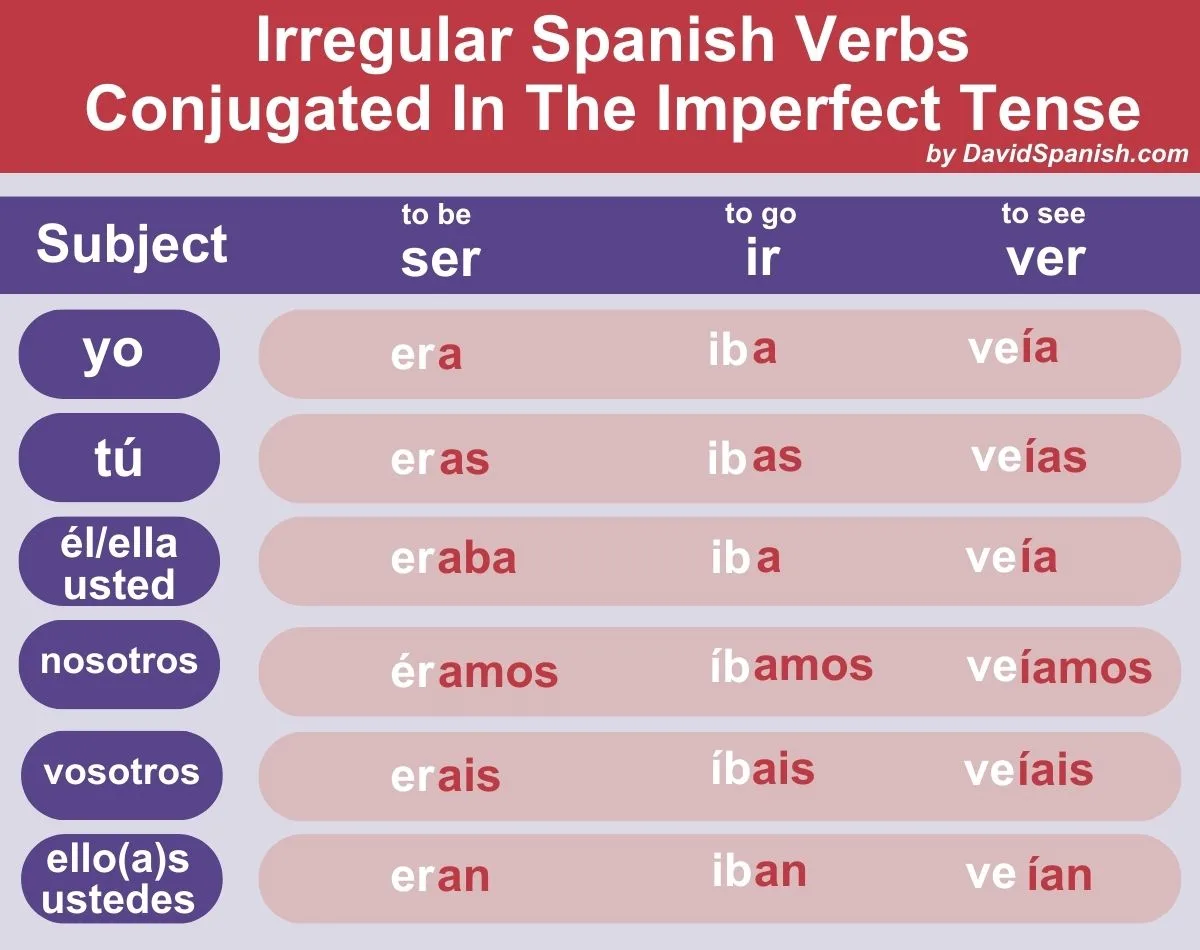How to use conjugate and use the imperfect tense in Spanish
The imperfect tense used to describe states of being and habitual actions in the past. It is used to express past continuous actions with unknown start and completion times. Equivalents for the imperfect in English are “used to do” and “was doing”. The imperfect is also used to provide background descriptions of past emotional, mental and physical conditions.
The first section of this post covers imperfect conjugation for regular and irregular verbs. Further down the page we’ll examine key uses of the imperfect as well as key differences in the imperfect vs. preterite tenses.

How to form the imperfect tense in Spanish
For Spanish AR verbs, the imperfect is conjugated by removing the -ar from the infinitive and adding the following endings: -aba, -abas, -aba, -ábamos, -abais and -aban.
For both ER verbs and IR verbs, the imperfect is formed by removing the -er or -ir from the infinitive and adding the following endings: -ía, -ías, -ía, -íamos, -íais and -ían.

Interestingly, the first-person singular (yo) and third-person singular (él/ella/usted) forms are the same for all Spanish verbs when conjugated in the imperfect.
There are three possible translations for all the verbs above. For example, yo hablaba can translate to “I was speaking”, “I used to speak” and “I spoke”.
Irregular verbs in the imperfect tense
The verbs ser (to be), ir (to go) and ver (to see) are all irregular in the imperfect.

Uses of the Spanish imperfect tense
The imperfect tense in Spanish is used to talk about and describe past actions where the duration of the action is unspecified. The uses vary a lot. We’ll list them below with with example sentences.
Habitual past actions
One of the most common uses of the imperfect is to describe past habitual actions. These are actions which occurred over time in the past and translate to “used to” or “would” in English.
- Yo esquiaba los domingos. I used to ski on Sundays.
- Cuando era nino, comía la pizza. When I was a child I used to (would) eat pizza.
The Spanish conditional tense is used to express hypothetical or “would” situations. That said, using the conditional for the above two example sentences would be wrong.
For example, you cannot say yo esquiaría los domingos to express “I would (used to) ski on Sundays”. To express actions which used to occur, you must use the imperfect tense in Spanish.
Ongoing past actions
The second most common use of the imperfect is to express past actions which occurring over time in the past. These are action which do not have an undetermined start and stop time. The English equivalent is verb + gerund (verb in -ing). For example “was eating”.
- Los niños jugaban. The kids were playing.
- La familia comía. The family was eating.
Past conditions
The imperfect is used for describing past conditions. These conditions can describe people, places and things. The imperfect is also used to describe external appearances and provide background information for telling stories.
The key aspect that all of the following example sentences have in common is that both the duration and beginning and end times of the described past events are unknown.
Descriptions of people and things
- El era guapo y timido. He was handsome and shy.
- Ella era alta y rubia. She was tall and blond.
Time, dates and days
- ¿Qué hora era? What time was it?
- Eran las cinco de la tarde. It was 5pm.
- Era el veinticinco de mayo. It was May 25.
- La clases era los lunes. The class was on Mondays.
Weather
- Llovía muchísimo. It was raining a lot.
- Hacía muy frío. It was very cold out.
Ages
- Ella tenía nueve años. She was nine years-old.
- Mi perro era viejo. My dog was old.
Thinking processes, states of mind
- ¡Yo no sabía! I didn’t know!
- Yo pensaba en ti. I was thinking about you.
- No quería salir. I didn’t want to go out.
- Esperaba encontrar una solución. I was hoping to find a solution.
Setting the scene for stories
- La casa era muy vieja. The house was very old.
- El cuarto era muy oscuro. The room was very dark.
Trigger words for the imperfect
Certain words trigger the use of the imperfect. These are words that suggest that the past event occurred many times. Such words include siempre (always), muchas veces (many times) and todos los días (every day) and de vez en cuando (from time to time).
- Yo fumaba de vez en cuando. I used to smoke from time to time.
- El siembre iba a la playa. He used to always go to the beach.
- Yo comía caramelos todos los días. I used to eat candy every day.
Imperfect vs. preterite
In this section we’ll have a look at four key differences between the imperfect and the preterite, another commonly used Spanish past tense.
1. Habitual vs. one time events
The Spanish language clearly distinguishes between actions that happened habitually or many times in the past and actions which only happened once.
- Imperfect: Habitualmente, yo miraba los partidos de fútbol. Usually, I watched soccer games.
- Preterite: Un día, yo miré un partido de tenis. One day, I watched a tennis match.
The imperfect is used to describe past conditions and situations. This is what people “used to do” and how past situations “used to be”.
The preterite is used to express when specific past actions occurred. These are storyline or plot events.
- Imperfect: Cuando Pedro vivía en Madrid, iba todos los días al parque. When Pedro lived in Madrid he used to (or would) go to the park every day.
- Preterite: El quince de mayo, Pedro fui al parque con su novia. On May 15, Pedro went to the park with his girlfriend.
Imperfect vs. conditional tense
A very common mistake is for beginners to confused the imperfect tense with the conditional tense. The conditional tense is used for expressing hypothetical actions.
For example, yo comería translates to “I would eat”. However, to express “I would eat” in context of “I used to eat”, you must use the imperfect tense. Hence, yo comía (I would/used to eat).
2. Progressive vs. sudden actions
Use the imperfect to express actions which were on going or in progress at a specified moment in time. Use the preterite to express actions which occur suddenly at a specific moment it time.
- A las ocho yo hacía mi tarea. I was doing my homework at eight o’clock.
- A las ocho terminé mi tarea. I finished my homework at eight o’clock.
If there are two past action with one ongoing and the other happening suddenly, the imperfect is used for the ongoing action and the preterite is used for the suddent action.
- Los niños jugaban cuando papá llegó. The kids were playing when dad arrive.
- Yo comía cuando me llamaste. I was eating when you called me.

3. Story telling
When telling stories, use the imperfect to express background details such as time, weather, outward appearances and mental states. Use the preterite to express story line or plot events.
- Imperfect: Era el cino de mayo. Estaba soleado y los ninos estaban jugando. It was May 5. It was sunny out and the kids were playing.
- Preterite: De repente, el maestro llegó y regañó a los niños. Suddenly, the teacher arrived and scolded the kids.
4. Si clauses with the imperfect and conditional
Use both the imperfect and conditional tense to express if-then clauses. In English, for example, “If I had money, I would travel”. The grammatical construction in Spanish is: Si + imperfect, then + conditional.
- Si yo tenía dinero, viajaría. If I had money, I would travel.
- Si yo hablaba español, yo sería muy feliz. If I spoke Spanish, I would be very happy.
- La Bamba Meaning, Spanish Lyrics & English Translation - May 4, 2024
- Bésame Mucho Meaning, Spanish Lyrics & English Translation - May 3, 2024
- Querida – Lyrics, Meaning & Translation - May 2, 2024
